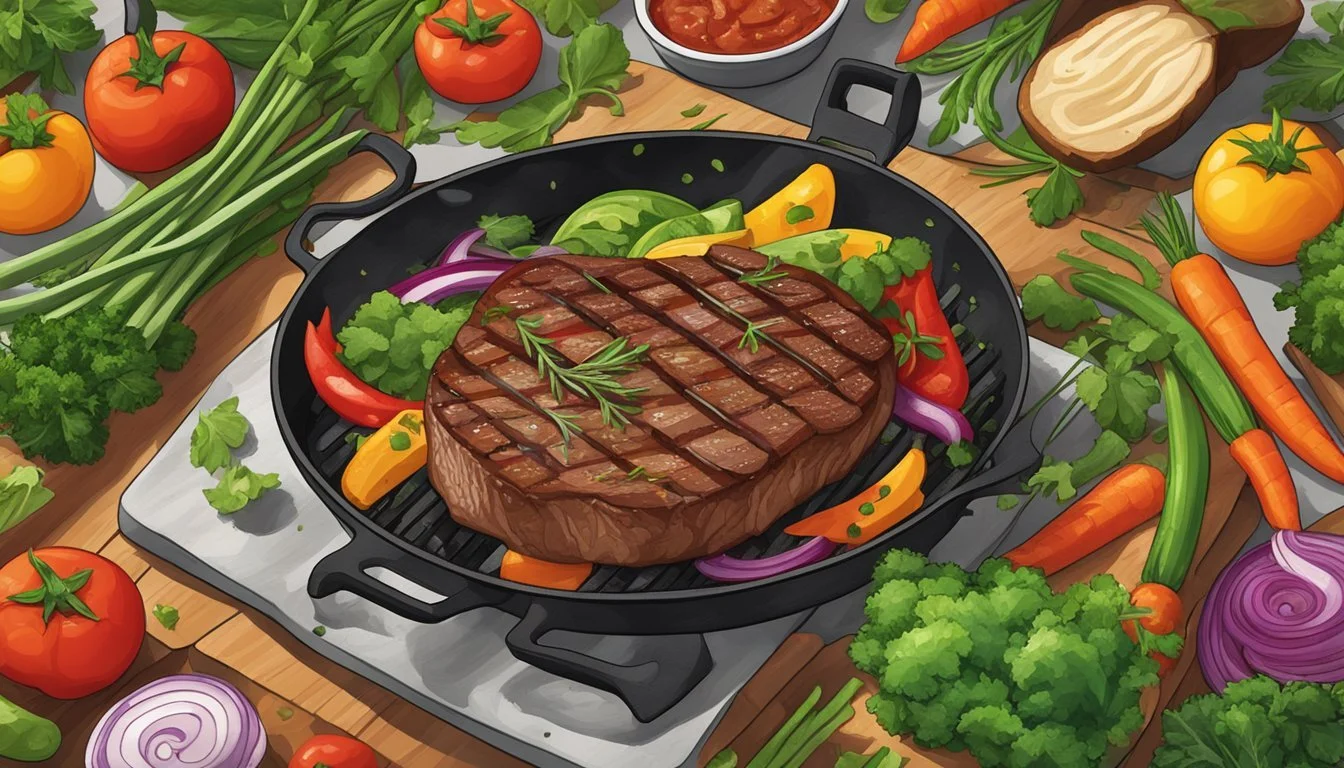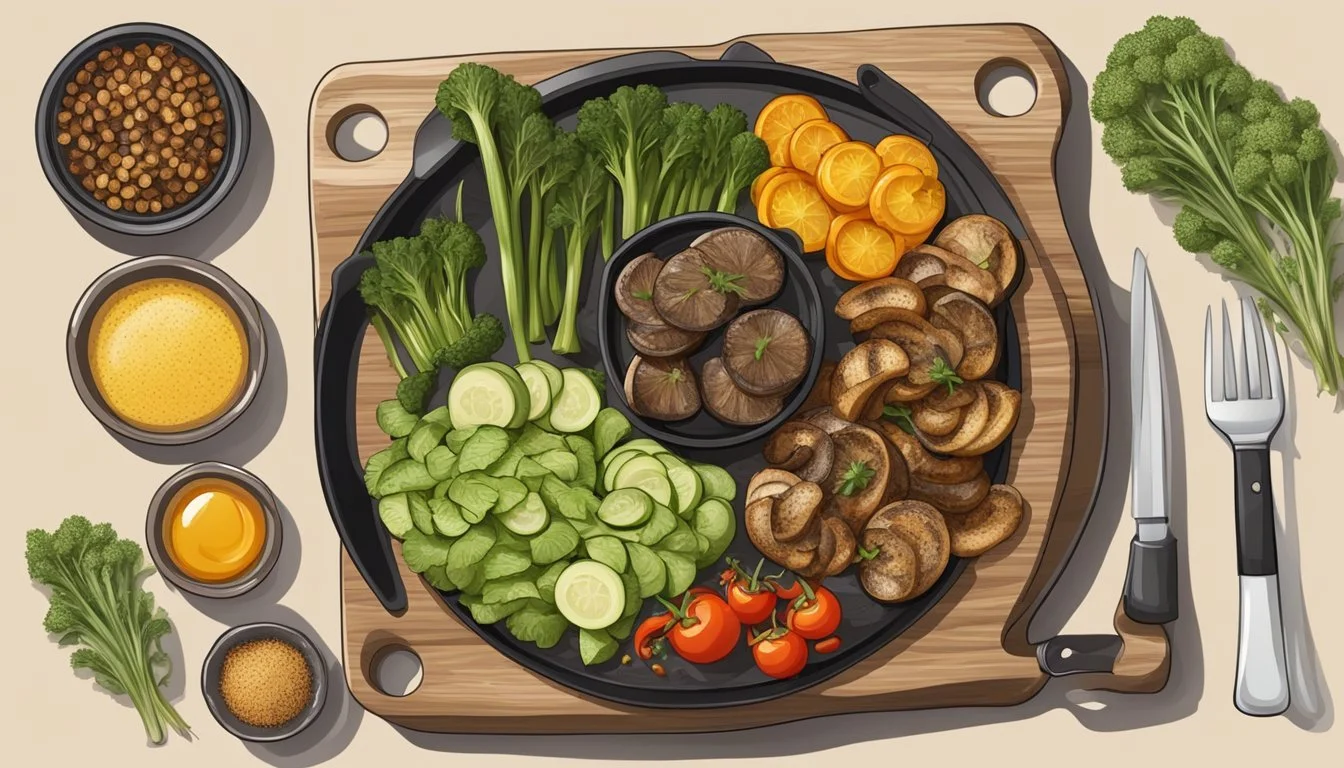Beef Steak Substitutes
Delicious Alternatives for Every Diet
Looking to enjoy a flavorful meal but don't have flank steak on hand? There are plenty of alternatives that not only mimic the texture and taste but also bring their own unique qualities to the table. Beef skirt steak is a nearly identical substitute, offering a similar tenderness and flavor profile, making it a top choice for many recipes.
If you're open to trying something with a slightly different texture, hanger steak is another excellent option. It comes from the underside of the cow near the loin and, while it has a higher fat content, it remains tender and flavorful when cooked properly.
For those looking for non-meat alternatives, portobello mushrooms and tofu serve as versatile and readily available replacements. While they don't mimic the exact texture of beef, they absorb flavors well and can be integrated into a variety of dishes, providing a satisfying and healthy option.
Understanding Beef Steak
Beef steak, known for its rich flavor and tender texture, varies widely depending on the cut, fat content, and cooking techniques employed. The following sections cover important aspects like cut and composition, common types, and different methods used to cook beef steak.
Cut and Composition
The quality and characteristics of beef steak primarily depend on the cut and its composition. Steaks are derived from different parts of the cow, each offering unique qualities.
Muscle fibers: Determine chewiness and texture.
Marbling: Intramuscular fat that enhances tenderness and flavor.
Fat content: Directly impacts juiciness and taste.
Each cut, like the top sirloin or flank steak, has distinct features that influence how it should be cooked for optimal flavor and tenderness.
Common Beef Steak Types
Several beef steak types are popular for their unique properties:
Top Sirloin: Versatile with good flavor and moderate tenderness.
Flank Steak: Lean with a rich, beefy flavor, best when not overcooked.
Flat Iron Steak: Known for its rich marbling and tenderness.
Skirt Steak: Flavorful but can be chewy; benefits from marination.
Hanger Steak: Higher fat content and tenderness, often cut thin.
Tri-Tip Steak: Tender and flavorful, often grilled.
Round Steak: Often tougher, suitable for slow-cooking methods.
Choosing the right type depends on the desired flavor, tenderness, and cooking method.
Cooking Techniques
Different cooking techniques bring out the best in various steak cuts:
Grilling: Ideal for cuts like tri-tip and top sirloin.
Pan Searing: Great for quickly cooking flat iron and hanger steaks.
Slow Cooking/Braising: Suited for tougher cuts like round steak and chuck roast.
Marinating: Enhances flavor and tenderness for leaner cuts like flank steak and skirt steak.
Smoking: Adds rich, smoky flavor perfect for brisket.
Factors like cooking time and heat level are crucial for achieving the desired texture and taste, from perfectly grilled sirloin to slow-cooked, tender round steak.
This detailed approach ensures each beef steak type is prepared to highlight its unique qualities and delivers a delicious dining experience.
Plant-Based Steak Alternatives
Plant-based steak alternatives offer a variety of delicious and high-protein options that can mimic the taste and texture of traditional beef steaks. Key substitutes include tofu, seitan, and various mushroom varieties.
Tofu and Seitan Options
Tofu is a versatile ingredient suitable for creating steak-like dishes. When pressed and marinated, tofu absorbs flavors well, making it an excellent choice for those seeking a vegan or vegetarian option. Firm tofu, in particular, can be grilled or pan-seared to achieve a texture similar to beef steak. Pairing it with a rich marinade enhances its flavor, making it a satisfying alternative.
Seitan, also known as wheat gluten, is another popular plant-based steak substitute. Known for its chewy texture, seitan closely mimics the mouthfeel of traditional meat. It can be seasoned and cooked in a variety of ways. Its high protein content and ability to absorb flavors make it a favorite among vegan and vegetarian consumers looking for a meat-like experience.
Mushroom Varieties
Portobello mushrooms are commonly used as a steak substitute due to their robust flavor and meaty texture. When marinated and grilled, they offer a satisfying bite that is both juicy and chewy. Portobello mushrooms also provide a rich, umami flavor that is similar to the savory notes found in beef steaks, making them an excellent choice for those looking to reduce their meat consumption without sacrificing taste.
Other mushroom varieties, such as shiitake and king oyster mushrooms, also serve as great steak alternatives. Shiitake mushrooms, with their dense texture and deep, earthy flavor, can be used in stir-fries or grilled dishes. King oyster mushrooms offer a firmer texture, which can be sliced and prepared in steak-like presentations. Both options are not only delicious but also packed with nutrients.
Non-Beef Meat Substitutes
When looking for non-beef meat substitutes, there are excellent options across poultry, other red meats, and seafood. Each category presents unique flavors, textures, and nutritional benefits, providing versatile alternatives for various dishes.
Poultry Alternatives
Chicken breasts are a lean and versatile substitute for beef steak. They are low in fat and high in protein, making them a healthy option. Chicken breasts can be grilled, baked, or sautéed and paired with a variety of marinades and seasonings to enhance flavor.
For a richer taste, consider duck breast. It is higher in fat compared to chicken but provides a more robust flavor. Duck breast is delicious when pan-seared and served with a fruity or savory sauce.
Other Red Meat Options
Bison is a flavorful alternative to beef steak. It is lower in fat and calories while still being rich in protein. Bison steaks can be cooked similarly to beef and offer a slightly sweeter, richer taste.
Venison offers a unique flavor that is both gamey and lean. Venison steaks, often from the loin, are tender and best when cooked to medium-rare to avoid toughness. They pair well with earthy herbs and robust sauces.
Seafood Selections
Tuna filet is a popular option when seeking non-beef substitutes. Rich in protein and omega-3 fatty acids, tuna offers a meaty texture and can be seared to rare or medium-rare for a steak-like experience.
Salmon is another excellent choice. It is flavorful, high in healthy fats, and versatile in cooking methods. Grilled, baked, or pan-seared salmon can stand in for beef steak in various dishes, offering a delicate but satisfying alternative.
These non-beef substitutes offer diverse flavors and textures that can cater to different preferences and dietary needs while offering a nutritious alternative to traditional beef steak.
Cooking and Preparation Tips
Effective preparation and cooking techniques can significantly enhance the flavor and texture of beef steak substitutes, making them a delicious alternative to traditional beef. The following subtopics cover vital tips on marinating and tenderizing as well as various cooking methods.
Marinades and Tenderizing
Marinades play a crucial role in enhancing the flavor and tenderness of beef steak substitutes. Using acidic ingredients like vinegar or citrus helps break down plant-based proteins. Popular marinade ingredients include soy sauce, garlic, herbs, and olive oil. To ensure thorough marination, immerse the substitutes for at least 30 minutes up to 24 hours.
Tenderizing techniques such as using a mallet or scoring the surface of the meat alternative can further improve texture. This makes the substitutes more palatable and helps in better absorption of marinades. Always ensure an even coating and adequate resting time for optimal flavor penetration.
Alternative Cooking Methods
Beef steak substitutes can be prepared using a variety of cooking methods to match different taste preferences. Grilling and broiling at high heat are excellent for developing a crispy exterior while maintaining a juicy interior. It’s essential to preheat the grill or oven to achieve a good sear.
For those who prefer slow cooking, methods like braising and stewing can add depth to the flavors. Using beef substitutes in stir-fries or as toppings for salads provides a quick and versatile meal option. Ensure the cooking temperature is appropriate for the substitute to avoid overcooking.
Considerations for Dietary Restrictions
Choosing a beef steak substitute involves various considerations such as health and nutrition benefits, budget constraints, and ethical or environmental effects. Here are detailed insights on each.
Health and Nutrition
The nutritional value of beef steak substitutes varies widely. Plant-based options such as tofu, tempeh, and seitan are great alternatives. Tofu, for instance, contains around 8 grams of protein per 100 grams, while tempeh offers up to 21 grams per 100 grams. These options are usually lower in fat compared to ground beef, which contains approximately 19 grams of protein but can be high in saturated fats.
Nutritional Highlights:
Tofu: 8g protein, low fat
Seitan: 25g protein, moderate fat
Tempeh: 21g protein, moderate fat
Adjusting portion sizes can help balance nutritional needs, especially for those on diets that limit animal fats and cholesterol.
Budget-Friendly Choices
Many beef steak substitutes are not only healthier but also budget-friendly. Lentils, beans, and chickpeas are excellent affordable options. They provide substantial protein content and are available in bulk, making them cost-effective.
For example, dry lentils cost roughly $1.50 per pound and offer about 18 grams of protein per cooked cup. Canned beans are even more budget-friendly and convenient, often priced at around $0.80 per can.
Cost Comparison:
Dry Lentils: $1.50 per pound
Canned Beans: $0.80 per can
Tofu: $2.00 per pound on average
These choices make it easier to stick to a nutritious diet without straining your budget.
Ethical and Environmental
Beef production has significant environmental impacts, including greenhouse gas emissions, deforestation, and water usage. Plant-based substitutes like those offered by brands such as Creative Pea are not only nutritious but also environmentally sustainable.
Key Points:
Lower Greenhouse Gas Emissions: Plant-based options generate less CO2.
Resource Efficiency: Require less water and land compared to beef farming.
Ethical Benefits: Align with vegan and vegetarian diets, avoiding animal harm.
In addition to their lower carbon footprint, these alternatives support sustainable agriculture practices, making them a responsible choice for the environmentally conscious consumer.
Switching to beef steak substitutes addresses both ethical concerns and environmental sustainability while offering diverse and nutritious options for various diets.
Cultural and Regional Variations
Different regions have their own unique takes on beef steak substitutes, providing a diverse range of culinary experiences. From Asian-inspired stir-fries to Mexican tacos and fajitas, these alternatives offer delicious and culturally rich options.
Asian-Inspired Dishes
Asian cuisine features a variety of beef steak substitutes, particularly in the form of stir-fries and other flavorful dishes. Ingredients such as tofu, tempeh, and seitan are often used to create dishes that mimic the texture and taste of beef. For instance, Mongolian beef can be made using seitan, which absorbs the rich flavors of garlic, soy sauce, and ginger, providing a satisfying and robust alternative.
Another popular substitute is jackfruit, which, when cooked, takes on a meaty texture and is often used in dishes like Korean BBQ. These plant-based alternatives are not only rich in protein but also cater to health-conscious consumers looking to reduce their meat intake without compromising on flavor.
Mexican and Tex-Mex Favorites
Mexican and Tex-Mex cuisines also offer exciting beef steak substitutes. Flank steak substitutes such as portobello mushrooms or tofu are commonly used in fajitas, providing a similar mouthfeel and taste experience. These substitutes can be marinated in traditional spices like cumin, chili powder, and paprika to enhance the flavor profile.
In tacos, lentils and black beans serve as excellent alternatives to ground beef. When spiced and cooked properly, they offer a hearty and satisfying filling. Additionally, soy-based crumbles are frequently used for their high protein content and ability to mimic the texture of beef.
These varied options showcase how beef steak substitutes can be seamlessly integrated into different cultural cuisines, offering flavorful and nutritious alternatives to traditional meat dishes.







